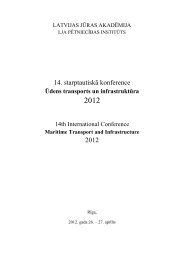Latvian Maritime academy
Latvian Maritime academy
Latvian Maritime academy
Create successful ePaper yourself
Turn your PDF publications into a flip-book with our unique Google optimized e-Paper software.
Training standards<br />
It can be argued that the ISM code insists on familiarization periods for new members. Nevertheless,<br />
training for these systems is not always achievable for a mariner joining a vessel just prior to departure or<br />
a pilot boarding a vessel. Training for different designs of equipment ashore is difficult financially<br />
(equipping a training centre with different systems) as well. Seafarers always find themselves required to<br />
use at sea systems different from those they were trained to use. However, manufacturers can provide<br />
assistance and guide specific training by supplying such adequate tools as software and complete<br />
manuals.<br />
In addition, the STCW did not provide any specifications for simulators required training, except for<br />
Radar/ARPA simulators. Also with the rapid development of technology and the wide use of GMDSS<br />
(Mandatory), ECDIS, AIS, and VDR onboard ships there is no criteria for training mentioned in STCW.<br />
There are many challenges encountered when we address and assess practical training needs for mariners<br />
in using technology based systems aboard, in order to be able to use technology based systems to make<br />
safe decisions.<br />
It is not clear who should bear the costs of developing equipment specific training. However,<br />
Computer Based Training (CBT), Computer Aided Learning (CAL), and most importantly Distance<br />
Learning (DL) which is defined by the American institute for distance learning as “the bridge that covers<br />
the time and distance gap between learners and tutors” can provide the required modules for equipment<br />
use onboard or even ashore before joining the vessel. Accordingly, this can aid to improve the training<br />
and familiarization situation. It would be worthwhile to mention that technical manuals were reported to<br />
be insufficient training tools. Unfortunately, in many cases training on new technology is only focused on<br />
the use of the equipment and not on the use of the technology to assist the decision making process. The<br />
wide impact of this procedure will handicap the capabilities of seafarers.<br />
No doubt, ECDIS and AIS are adding-value equipment that could improve the operations when it is<br />
used by well-trained officers who are good at managing and evaluating information. However, the same<br />
equipment can cause a disaster when it is used by an officer without skills in perceiving and prioritizing<br />
information. Nevertheless, there are numerous arguments about reliance upon them as it is said that their<br />
use has to be balanced with other appropriate means.<br />
Recommended solutions<br />
According to International Federation of Shipmasters’ Associations (IFSMA, 2003) “Cascade<br />
training for onboard technology based systems (engineering, cargo, navigation, communication) may not<br />
be adequate to ensure safe operation”, as there is no sufficient time to train. In addition, the officer<br />
providing the training may not fully understand the system themselves or may not be sufficiently capable<br />
of training or assessing.<br />
Another new technology which is applied today on many modern ships is the Integrated Navigation<br />
system (INS) or, Integrated Bridge system (IBS), in an attempt by ship-owners to save the operating costs<br />
by appointing minimum crew onboard can result in “minimum manning” and not “safe manning”.<br />
Though it has recognized advantages such as better use of ship technology, advanced team work,<br />
financial savings, it also has major recognized disadvantages. Namely, the watch office is heavily<br />
burdened and stressed, with the must of monitoring various monitors, gauges and variable alarm<br />
responses. Moreover, there is an absolute need to teach such officers to handle this equipment, yet we<br />
find no training standards available in the STCW.<br />
Safe Cargo could be used for tankers safe training for liquid cargo operations. It is a flexible training<br />
simulator that provides real-time simulation of the thermodynamic and fluid properties of the liquids and<br />
gases involved, together with the process control systems used in the storage and handling of potentially<br />
hazardous bulk liquids. The system is primarily intended to be used for the training of personnel involved<br />
in handling of bulk liquids. In order to facilitate modern training for seafarers, many curriculum should be<br />
revised, as much valuable time is wasted on studying and training on obsolete topics with no reference to<br />
modern technologies applied on board today.<br />
32
















